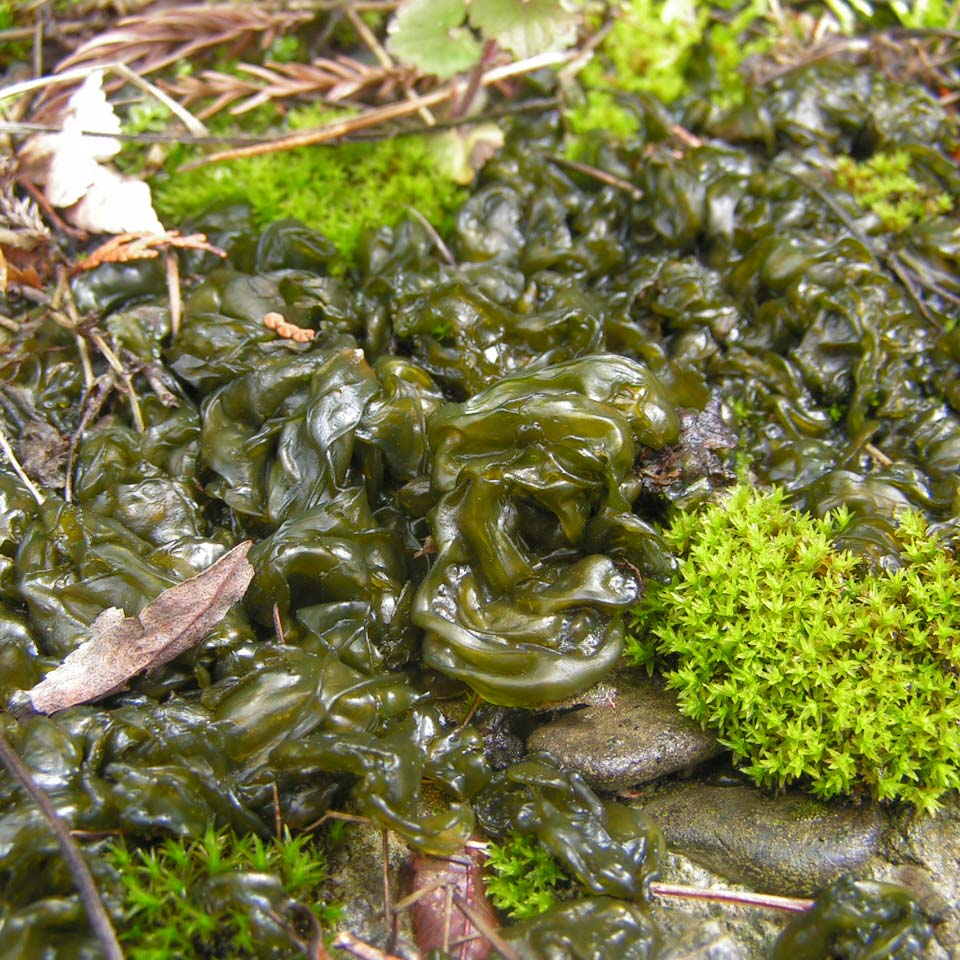
Have you noticed a strange green jelly growing on your lawn? It may look strange or even alarming at first. But this unusual organism is nothing to be afraid of. It is not harmful to plants or animals, though it does look unpleasant on your lawn. Getting rid of it can be a challenge, but a combination of chemical and cultural practices can clear your lawn.
What is Nostoc?
That strange green jelly growing on your lawn is called Nostoc. It also has many common and historical names, including witch’s butter and star jelly. The latter name comes from an old belief that Notsoc was the seeded by stardust from shooting stars.
While it may be tempting to think of the slimy green mass as an alien life form, it is actually a long-time resident of planet earth. Scientists studying the fossil record believe that cyanobacteria like Nostoc are some of the oldest living organisms on earth, first appearing 3.5 billion years ago. Since then, Nostoc has developed into over 200 species that colonize nearly every habitat on earth, including some of the most inhospitable places on earth. Nostoc is present in freshwater, saltwater, and terrestrial habitats. Due to its protective coating, Nostoc can withstand flooding, drought, and freezing, so that it is present everywhere from deserts to the Arctic. As an organism that has been around for 3.5 billion years, it should come as no surprise that Nostoc is not easy to kill.
Nostoc is sometimes referred to as blue-green algae. However, Nostoc is not technically algae. Algae are plants. Nostoc is a cyanobacterium, a single-celled organism with no cell nucleus. While the individual cyanobacteria are microscopic, they can grow together in colonies that can be seen with the naked eye. The colony is covered in a protective jelly that gives Nostoc its unusual slimy appearance.
Problems Caused By Nostoc
Nostoc is not poisonous or harmful to plants or animals. It won’t kill your turfgrass. However, it is not without its problems. First, the unsightly green jelly growing on your lawn is rather unpleasant to look at. If you are trying to grow a lawn, patches of green slime do not contribute to the turfgrass aesthetic. However, the slimy texture can also be a safety hazard. The jelly-like substance that covers the colony is extremely slippery. If Nostoc is growing in an area of your lawn that gets foot traffic, it can cause a slip-and-fall hazard. And Nostoc isn’t restricted to your lawn. Nostoc can also grow on rocks and pavement, such as walkways and driveways. On a hard surface like that, Nostoc can be especially slippery and dangerous to walk on.
![Nostoc A Green Jelly Growing On Your Lawn [infographic]](https://theturfgrassgroup.com//wp-content/uploads/2020/06/Nostoc-A-Green-Jelly-Growing-On-Your-Lawn-infographic.jpg)
Why Do I Have Nostoc In My Lawn?
Nostoc typically appears after heavy rain. The cyanobacterium may exist in a black, crusty state during dry periods. But as soon as it rains, the Nostoc expands and grows its jelly-like covering.
It is important to recognize that Nostoc does not kill turfgrass, and it will not damage your lawn. However, Nostoc does indicate lawn problems. Nostoc doesn’t grow in a part of your lawn with thriving turfgrass. On the contrary, Nostoc fills in areas where the grass is already thin. So if you are noticing Nostoc on your lawn, you have some work to do on your turfgrass.
Nostoc is also indicative of drainage issues. The type of Nostoc that appears on grass lawns needs a lot of water to grow and spread. It typically pops up in areas with puddles and standing water. So if you are noticing it on your lawn, one of the first places to look is at your lawn’s drainage.
Treating Nostoc on Your Lawn
Treating Nostoc on your lawn can be as simple as removing the conditions that allowed for its growth in the first place. However, an organism that has survived for 3.5 billion years isn’t easy to kill.
Remove Standing Water
The first thing you need to do if you want to get rid of Nostoc is to check your lawn’s drainage. After a heavy rain, does water puddle on your lawn? Also, are you watering your lawn more than necessary? Remember that your lawn only needs about an inch of water every week, and if it rains, that is more than sufficient without any additional irrigation.
If the problem is standing water, there are several techniques to improve drainage. First, check for low spots in your lawn where water may be pooling. If water is pooling in depressions in your yard, you can easily correct the situation by adding soil and filling in the depressions. If your lawn is flat, but water is still gathering and remaining after rain or regular irrigation, look at the texture of your soil. Soil that is too compacted doesn’t absorb water as well as it should. The same is true for very clayey soil.
To test your soil, try sticking a screwdriver straight into the dirt. If it easily slides into the dirt at least six inches, your soil is in good shape. But if the screwdriver won’t go in, or if you have to push hard, your soil is too compacted. The best solution for compacted soil is to aerate your lawn with a core or plug aerator. However, tilling or aerating your lawn can also break up and spread the Nostoc, so it may be necessary to kill the Nostoc with herbicide first.
Herbicide
Removing standing water removes the conditions for Nostoc to grow and flourish. However, if your lawn is already covered in large patches of Nostoc, you will need to kill the cyanobacterium before you can correct the drainage issues.
Although Nostoc is not technically a type of algae, herbicides labeled for moss and algae are often the most effective at killing Nostoc. It is best to apply the herbicide when the lawn is dry. Be careful to follow the directions carefully to avoid damaging the surrounding turfgrass.
Cultural Practices
The best way to beat Nostoc is to maintain a thick, healthy lawn. Nostoc will not grow in a healthy lawn. It only fills in areas where the grass is already thin. Overwatering can lead to weak grass, as well as create the wet conditions that favor Nostoc growth. In addition, the overuse of phosphorus fertilizers can fuel Nostoc growth. Before applying phosphorus fertilizers, test your soil. Soil testing is available at agricultural extension offices in most counties. The testing will tell you exactly how much phosphorus fertilizer your lawn needs and help prevent overfertilization.
Once Nostoc has taken hold in thin patches of your lawn, you will have to remove it for the grass to grow in. Wait until it is dry, and the Nostoc has reverted to its black crusty state. Then use a spade or shovel to remove the Nostoc and dispose of it in a landfill. The areas will fill in on their own if you are following general guidelines for healthy lawn growth. Don’t worry too much if a bit of the black crust ends up on your lawn. As long as the lawn is growing healthy turfgrass, the Nostoc will not take hold.
_____
Featured image by YAMAMAYA – Photo taken by YAMAMAYA, CC BY-SA 3.0, https://commons.wikimedia.org/w/index.php?curid=3919265
